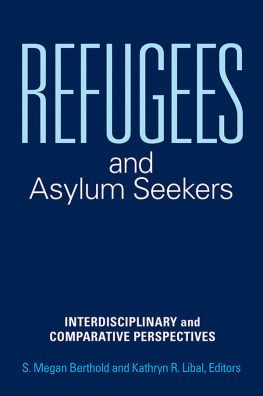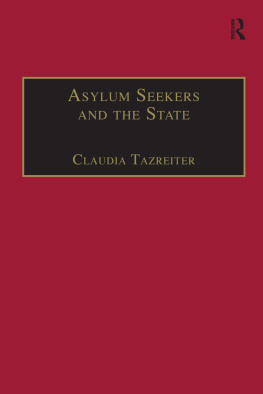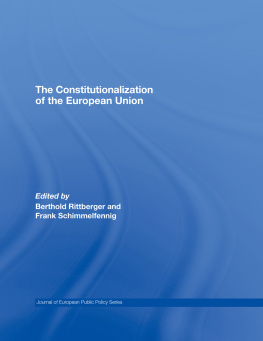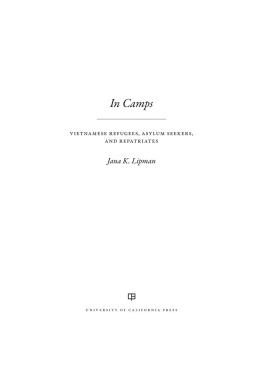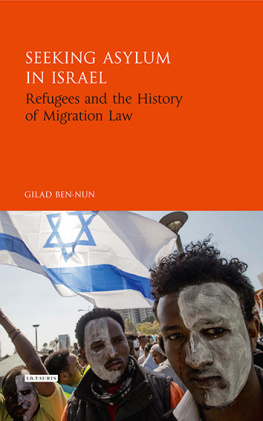S. Megan Berthold - Refugees and Asylum Seekers: Interdisciplinary and Comparative Perspectives
Here you can read online S. Megan Berthold - Refugees and Asylum Seekers: Interdisciplinary and Comparative Perspectives full text of the book (entire story) in english for free. Download pdf and epub, get meaning, cover and reviews about this ebook. year: 2019, publisher: ABC-CLIO, LLC, genre: Politics. Description of the work, (preface) as well as reviews are available. Best literature library LitArk.com created for fans of good reading and offers a wide selection of genres:
Romance novel
Science fiction
Adventure
Detective
Science
History
Home and family
Prose
Art
Politics
Computer
Non-fiction
Religion
Business
Children
Humor
Choose a favorite category and find really read worthwhile books. Enjoy immersion in the world of imagination, feel the emotions of the characters or learn something new for yourself, make an fascinating discovery.
- Book:Refugees and Asylum Seekers: Interdisciplinary and Comparative Perspectives
- Author:
- Publisher:ABC-CLIO, LLC
- Genre:
- Year:2019
- Rating:4 / 5
- Favourites:Add to favourites
- Your mark:
- 80
- 1
- 2
- 3
- 4
- 5
Refugees and Asylum Seekers: Interdisciplinary and Comparative Perspectives: summary, description and annotation
We offer to read an annotation, description, summary or preface (depends on what the author of the book "Refugees and Asylum Seekers: Interdisciplinary and Comparative Perspectives" wrote himself). If you haven't found the necessary information about the book — write in the comments, we will try to find it.
S. Megan Berthold: author's other books
Who wrote Refugees and Asylum Seekers: Interdisciplinary and Comparative Perspectives? Find out the surname, the name of the author of the book and a list of all author's works by series.
Refugees and Asylum Seekers: Interdisciplinary and Comparative Perspectives — read online for free the complete book (whole text) full work
Below is the text of the book, divided by pages. System saving the place of the last page read, allows you to conveniently read the book "Refugees and Asylum Seekers: Interdisciplinary and Comparative Perspectives" online for free, without having to search again every time where you left off. Put a bookmark, and you can go to the page where you finished reading at any time.
Font size:
Interval:
Bookmark:

Copyright 2019 by S. Megan Berthold and Kathryn R. Libal
All rights reserved. No part of this publication may be reproduced, stored in a retrieval system, or transmitted, in any form or by any means, electronic, mechanical, photocopying, recording, or otherwise, except for the inclusion of brief quotations in a review, without prior permission in writing from the publisher.
Library of Congress Cataloging in Publication Control Number: 2019941201
ISBN: 978-1-4408-5495-8 (print)
978-1-4408-5496-5 (ebook)
232221201912345
This book is also available as an eBook.
Praeger
An Imprint of ABC-CLIO, LLC
ABC-CLIO, LLC
147 Castilian Drive
Santa Barbara, California 93117
www.abc-clio.com
This book is printed on acid-free paper 
Manufactured in the United States of America
Dedicated to Craig and Scott
Richard F. Mollica
Kathryn R. Libal and S. Megan Berthold
Karen Musalo
Carol Bohmer and Amy Shuman
Kathryn R. Libal, Grace Felten, and Scott Harding
Marciana Popescu
J. David Kinzie and Crystal Riley
Linda Piwowarczyk, Kathleen Flinton, and Fernando Ona
Adeyinka M. Akinsulure-Smith and Hawthorne E. Smith
S. Megan Berthold and Alysse M. Loomis
Alysse M. Loomis and S. Megan Berthold
Toby Measham, Jaswant Guzder, G. Eric Jarvis, Rayanne Elias, Ccile Rousseau, Lucie Nadeau, and Ghayda Hassan
Badiah Haffejee and Jean F. East
Amber Elizabeth L. Gray
S. Megan Berthold and Kathryn R. Libal
Richard F. Mollica
The largest mass lynching in American history took place in New Orleans, Louisiana, on March 14, 1891. The following day, a New York Times editorial supported these public executions:
These sneaking and cowardly Sicilians, the descendants of bandits and assassins, who have transported to this country the lawless passions, the cut-throat practices, and the oath-bound societies of their native country, are to us a pest without mitigation. Our own rattlesnakes are as good citizens as they Lynch law was the only course open to the people of New Orleans. (The New Orleans Affair 1891, 4)
The lynch mob had murdered nine Italian American immigrants. These Italian immigrants had been found to be not guilty of the murder of Police Chief David Hennessy. Despite their innocence, they were killed by an angry mob that was strongly supported by the general public and prominent local politicians. Attorney William S. Parkerson rallied the support of community members and decried the jurys decision, denouncing them as perjurers and scoundrels. The angry mob then marched to the jailhouse. Among the participants were John M. Parker and Walter C. Flower. Each would go on to hold gubernatorial positions in Louisiana. Parker, who would go on to become Louisianas 37th governor, famously stated as follows in 1911 about Italians: just a little bit worse than the Negroes, being if anything filthier in [their] habits, lawless, and treacherous (Falco 2012, 2).
In 1899, in Tallulah, Louisiana, three Italian American shopkeepers were lynched because they had treated black customers the same as white customers. The lynch mob hung five members in total related to this eventthe three shopkeepers and two bystanders (Schoener 1987).
These events marked the beginnings of Americas public acceptance of Italian Americans as a race of ambiguous color (i.e., neither white nor black) and as people of intrinsic criminality and inferior mental intelligence.
While America has a proud immigrant history, it also has a strong element of debasing and dehumanizing the other, including violent hostility and even death (Falco 2012). I would like to briefly focus on the historical racial prejudices directed toward Italian Americans to illuminate a model similar to current sociopolitical factors and trends that impact modern-day immigrant groups entering (or trying to enter) the United States. It would then be helpful to examine the theoretical principles that might explain Americas long-standing racial hatred of refugees and immigrants and finally to suggest possible social solutions to this problem of inflicting pain and suffering on the other. I have chosen to use Italian Americans as an example of our countrys stigmatization and ostracism of the other because of my firsthand experiences as an Italian American child growing up in the urban ghetto of the South Bronx. My family was no stranger to the systemic forces of acculturation and institutionalized racism. I was the son of two parents who were orphaned by tragic events related to racism. When I was a student, I was subject to the micro-aggressions of the institutions where I sought my education. These forces were not merely artifacts of the past, but to this day, I have worked in environments that continue to make slights toward Italian Americans.
Clearly, no discussion of racial oppression and exploitation can begin without acknowledging the enormous suffering of the African American communities, which had experienced slavery, and the genocide of the Native Americans. The intergenerational impact of violence on these communities continues to this day from generation to generation. Individuals and families from many countries in Asia, Latin America, Africa, and the Middle East have faced significant oppression and violence as well in the United States and other countries they have immigrated to. Having spent the past four decades working with survivors of mass violence and torture, I have seen the ripple effects violence can have on a community. Violence leads to a serious impact on the health and well-being of survivors decades after the major events have occurred and continues to affect the health and well-being of each new generation. Post-traumatic stress disorder (PTSD) is never post; it is always ongoing.
Racial prejudice toward Italian Americans is embedded in the long-standing racial slang Americans have used to describe an entire group of immigrant peoples. The word Guinea was used as a derogatory word for an Italian and is derived from the term Guinea Negro, which referred to black persons of mixed ancestry. The Italians were considered black people or people of ambiguous color but certainly not white people. Another racially charged ethnic slur for Italians is the term Wop. Merriam-Webster dictionary says it was first used in America in 1908 and originates from the Italian word guappo. In Southern Italian dialect, guappo is a friendly term broadly meaning dandy, dude, or stud. Unfortunately, Americans transformed this into a derogatory term for Italians.
Each of these terms would be and still are considered by Italian Americans as the equivalent of the N-word for African Americans. The discrimination toward Italian Americans hit a high point in the 1920s. The Immigration Act of 1924 or Johnson-Reed Act included the National Origins Act and the Asian Exclusion Act. These actions by Congress, signed into law by President Coolidge on May 24, 1924, strongly restricted the immigration of Italians (among many other races) into the United States. The proponents of this act, strongly supported by Congress, used the following arguments to legislate fewer admissions by certain countries. Arguments that favored Northern European immigrants as opposed to Southern European immigrants included maintaining the racial preponderance of the basic strain of our people and hereby stabilize the ethnic composition of the population (U.S. Immigration and Migration Reference Library 2004). The supporters of the bill believed that Italians (and similar races) were sickly, disease ridden, and mentally feeble, incapable of contributing and adjusting to American culture. The people who supported these laws used eugenics (Galton 1904; Gould 1981) as a justification for restrictions on entering into America because they feared Italians would marry healthy, white non-Italian-American women and produce mentally limited childrenand the latter would threaten our democracy.
Font size:
Interval:
Bookmark:
Similar books «Refugees and Asylum Seekers: Interdisciplinary and Comparative Perspectives»
Look at similar books to Refugees and Asylum Seekers: Interdisciplinary and Comparative Perspectives. We have selected literature similar in name and meaning in the hope of providing readers with more options to find new, interesting, not yet read works.
Discussion, reviews of the book Refugees and Asylum Seekers: Interdisciplinary and Comparative Perspectives and just readers' own opinions. Leave your comments, write what you think about the work, its meaning or the main characters. Specify what exactly you liked and what you didn't like, and why you think so.

